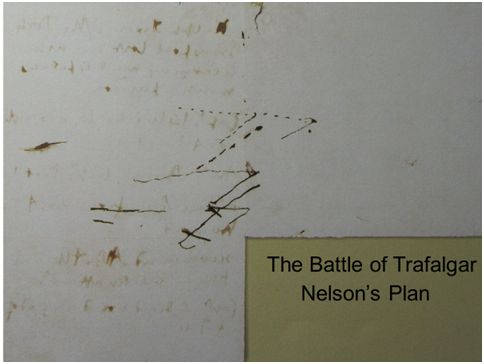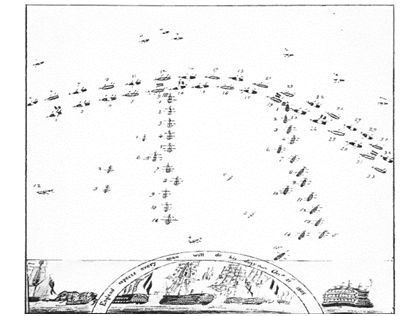


Our Speaker on 13 September was fellow-member Ian van Oordt whose topic was the Battle of Trafalgar, a follow-on talk of the Trafalgar Campaign in March. The Power Point presentation included a number of excellent paintings by the well-known UK marine artist Geoff Hunt.
Mr van Oordt started histalk with a quick review of his previous talk on the events leading up to the battle. He dealt with Nelson’s chase to the West Indies in search of the combined fleet as well as the battle known as Calder’s Action on 22 July 1805, finally culminating with the Combined Fleet retiring to Cadiz.
When Napoleon, on the 1st September, finally learnt that his grand plan to amass the Combined Fleet with the other French ships of the line stationed at Rochefort and Brest had failed, he was furious. Whilst this was going on the Austrian army was amassing on his eastern border, and he had to move the invading army at Boulogne to counter this threat.
With the Combined Fleet now blockaded at Cadiz, Britain could breathe a sigh of relief from the threat of invasion. Novel ideas on how to destroy the Combined Fleet were thought up, one of them, which was proposed by Sir Sydney Smith, was authorized by Parliament. The plan was to use a Fireship attack but the difficulty of getting the Fireships into position and then allowing them to drift into the anchorage position was thought to be too difficult. The sailors attempting such an attack would no doubt be captured. That attempt was abandoned.
Nelson returned to England and went on leave for a short while. On 15 September he departed from Portsmouth in HMS Victory to take command of the Mediterranean fleet off Cadiz.
Napoleon in the meantime abandoned his plan for the invasion of England and issued instructions to Villeneuve to proceed to Toulon were the troops on board the ships could be used to counter the threat on his eastern border. He issues this instruction to Villeneuve on 26 September and by sheer coincidence Nelson arrives to take over command of the Mediterranean fleet of Cadiz on the same day. Nelson sent the frigate HMS Euryalus ahead to advise Admiral Collingwood not to fire any salutes on his arrival. He also kept the reinforcements further out to sea thus concealing his actual force from Villeneuve.
On 20 October 1805 the combined fleet departs from Cadiz and heads for the straights of Gibraltar. The combined fleet consists of 33 ship of the line, five frigates and two brigs. On board are 25,200 men, and 2,652 cannon of various calibres. The Mediterranean fleet under Nelson has 27 ships of the line, four frigates, one brig and a cutter. On board are 17,076 men, and 2,178 cannon of various calibres.
Nelson had discussed his proposed action plan a number of times with his commanders. A sketch, made during one of these discussions, was later found in his papers, clearly demonstrating his intention. By cutting the enemy’s line into three parts, the lead ships of the enemy Combined Fleet would have difficulty in turning around and then tacking numerous times (due to the wind blowing in the wrong direction) to be able to return to the battle. This effectively would give the British ships a temporary numerical advantage, so important in a battle.

In the early morning on 21 October the two fleets were in sight of each other. The British fleet was quickly formed up into two columns and proceeded to cut the enemy line. The combined fleet on the other hand was in disorder. Instead of been formed up in line of battle, they formed a crescent arc with some sections of the line two or three ships deep.

Sketch of the Start of the Battle
Just before the start of the battle Nelson raised his famous signal “ENGLAND EXPECTS THAT EVERY MAN WILL DO HIS DUTY” and then finally his last flag order “ENGAGE THE ENEMY MORE CLOSELY”.
The wind was light, Admiral Collingwood’s column was the first to break the Combined Fleet’s line at 12h04. HMS Victory, however, was subjected to the fire from the Combined Fleet for nearly 30 minutes before she finally broke the line at 12h59.
Victory’s first broadside into the French ship Bucentaure created great death and destruction. Having broken the line, Victory then fell in with the French ship Redoutable. The two ships were locked together by the yard arms. Nelson, pacing the quarterdeck with Captain Hardy, was shot through the left shoulder by a rifleman in the tops at 13h25.
He was carried below and died of his wound at 16h30, but not before the great British victory was announced to him.
British losses amounted to 449 killed and 1,241 wounded. The Combined Fleet losses were never properly documented and are estimated at 4,500 killed or wounded and 12,000 taken prisoner.
French and Spanish ship losses amounted to 18 captured and 1 burnt. Of the 18 ships that were captured, 6 were wrecked in the storm that followed the battle, 4 escaped and were later recaptured, 4 destroyed and 4 taken into British service.
The chairman thanked Mr van Oordt for a very interesting talk and presented him with the customary gift.
COMMITTEE NEWS
We are approaching the end of the year; it has passed in a flash. The committee has been hard at work organizing talks; we wish to thank those members for their input in this regard. At the meeting on 26 June 2018 the committee finalized the talks for the year. Our final talk for this year will be in November. We have started to approach other speakers and we hope to have a bumper crop next year.
We have also decided to broaden the scope of topics so as to encourage other people to join the Society. We trust you have enjoyed the last three talks and would appreciate getting your feedback Please contact any committee member to give your feedback, we appreciate all input both positive and negative.
The committee has also completed updating the members list. It would appear that we do not have the correct details for all members, please contact a committee member should you not be receiving any communications from the Society.
IN MEMORY - MR HASEWINKEL
The committee is sad to announce the death of Mr Werner Hasewinkel, a long-standing member of the Cape Town branch, on the 22 August 2018. Mr Hasewinkel served with the Wehrmacht Panzer corps on the Western Front. He is survived by his wife and daughter. The Society sends their sincere condolences to the family.
FORTHCOMING MEETINGS
THURSDAY, 11 OCTOBER 2018: OPERATION BARBAROSSA - PART 2: THE WINTER CAMPAIGN – GREG PULLIN.
Greg Pullin follows on from his previous talk on the initial German invasion of Russia in 1941. His talk will deal with the Soviet Winter Campaign which started on the 5th December 1941 to the defeat of the German 6th Army at Stalingrad and its aftermath in the German Operation Winter Storm, which collapsed on 24 December 1942.
Greg is an avid model builder and has a keen interest in aviation and World War 2 history. He is a founder member of the Friends of the SAAF Museum in Cape Town and Port Elizabeth. His interest in World War 2 has taken him overseas to Europe to visit battle sites and aircraft shows. He is a keen war gamer and works mainly to support his hobbies.
THURSDAY, 8 NOVEMBER 2018: - THE "TANK BATTLE" OF CAMBRAI: FACT OR MYTH? – JOHAN VAN DEN BERG.
Cambrai was the last battle fought by the British on the Western Front in 1917. Although Cambrai is remembered as the world’s first great “tank battle”, its real historical importance lies in the fact that it was one of the most influential battles of the 20th century with the introduction of mechanical warfare and the tactical innovation of combined arms operations. Over the past hundred years many myths saw the light about the “tank battle”. Cambrai ended in a draw. Ironically, history has recorded it as a “British victory”. Perhaps, a flaw brought about by the old adage of “the victor writes the history”?
Johan van den Berg is our ex-chairperson and long-standing member and therefore needs no introduction to the members. His passion for research and understanding history, and in particular military battles, makes him a virtual encyclopaedia on the subject. His knowledge allows him to cover most wars through the ages, bringing to life little-known facts and a unique talent for separating FACT from FICTION.
Ian van Oordt (Secretary)
021 531 6612